Kuwaiti newspaper cites unnamed senior source as saying Jerusalem behind recent incidents in Iran, following an alleged attempt by Tehran to hack Israel’s water infrastructure.
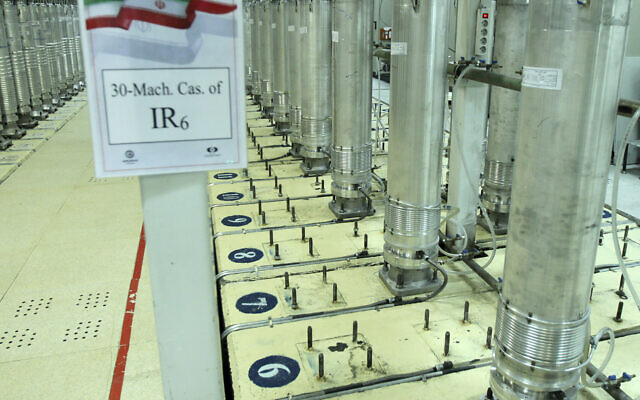
Centrifuge machines in the Natanz uranium enrichment facility in central Iran, November 5, 2019. (Atomic Energy Organization of Iran via AP, File)
Israel was responsible for two blasts at Iranian facilities — one related to uranium enrichment, the other for missile production — over the past week, a Kuwaiti newspaper reported Friday.
The Al-Jareeda daily cited an unnamed senior source as saying that an Israeli cyberattack caused a fire and explosion at the largely underground Natanz nuclear enrichment facility in the predawn hours of Thursday morning.
According to the source, this was expected to set back Iran’s nuclear enrichment program by approximately two months.
The newspaper also reported that last Friday Israeli F-35 stealth fighter jets bombed a site located in the area of Parchin, which is believed to house a missile production complex — an area of particular concern for the Jewish state, in light of the large number and increasing sophistication of missiles and rockets in the arsenals of Iranian proxies, notably Lebanon’s Hezbollah.
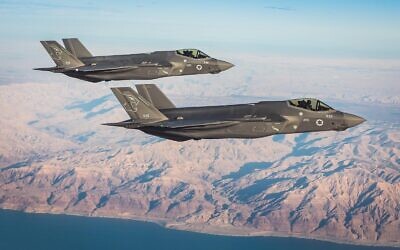
Fighter jets from the IAF’s second F-35 squadron, the Lions of the South, fly over southern Israel (IDF spokesperson)
Neither of these claims were confirmed by Israeli officials, who have been mum on the reports.
The reported Israeli strikes followed an alleged Iranian attempt to hack into Israel’s water infrastructure in April, an effort that was thwarted by Israeli cyber defenses, but if successful could have introduced dangerous levels of chlorine into the Israeli water supply and otherwise seriously interrupted the flow of water throughout the country.
Ultimately, the alleged Iranian cyberattack caused minimal issues, according to Israeli officials.
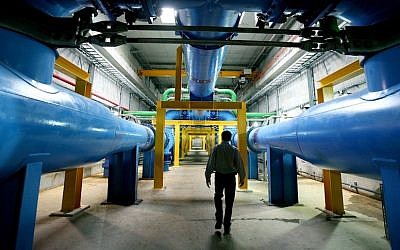
View of the Eshkol Water Filtration Plant in Northern Israel (Moshe Shai/FLASH90)
The alleged Israeli attacks also came amid an ongoing campaign of so-called maximum pressure by the United States in the form of crushing sanctions on Iran and Iranian officials.

View of the Eshkol Water Filtration Plant in Northern Israel (Moshe Shai/FLASH90)
Early Thursday morning, a fire and then an explosion were reported at an above-ground building in the Natanz nuclear enrichment facility, which US-based analysts said was likely a new centrifuge production plant. Natanz, located some 250 kilometers (155 miles) south of Tehran, includes underground facilities buried under some 7.6 meters (25 feet) of concrete, which offers protection from airstrikes.
Photographs of the site showed significant damage to one above-ground building, which was covered in scorch marks and had its roof apparently destroyed.
The BBC’s Persian service said it received an email from a group identifying itself as the “Cheetahs of the Homeland” claiming responsibility for the attack. The email was received prior to the announcement of the Natanz fire.
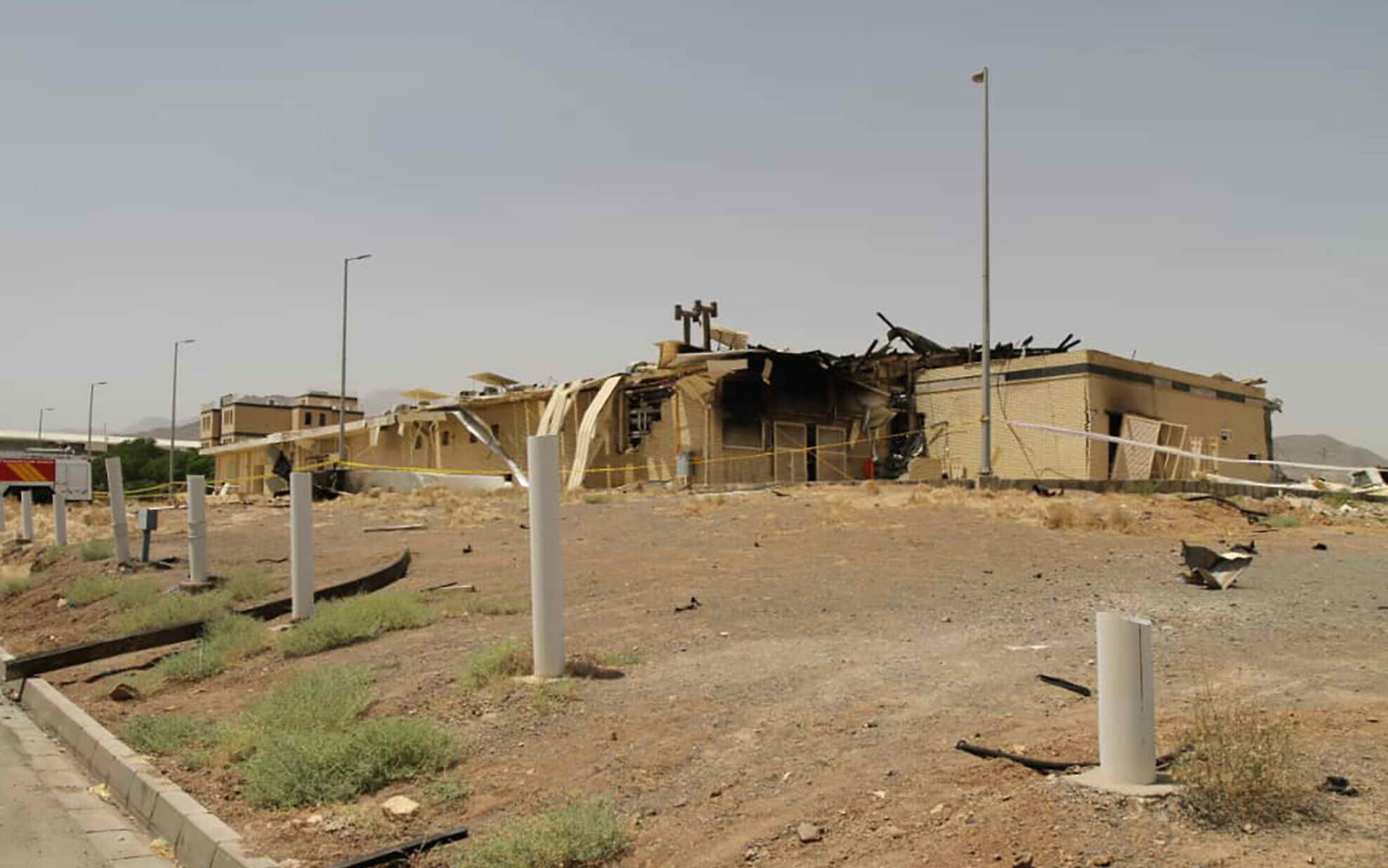
This photo released on July 2, 2020, by the Atomic Energy Organization of Iran, shows a building after it was damaged by a fire, at the Natanz uranium enrichment facility some 200 miles (322 kilometers) south of the capital Tehran, Iran. (Atomic Energy Organization of Iran via AP)
The group, which claimed to be dissident members of Iran’s security forces, had never been heard of before by Iran experts and the claim could not be immediately authenticated by The Associated Press.
The site of the fire corresponds to a newly opened centrifuge production facility, said Fabian Hinz, a researcher at the James Martin Center for Nonproliferation Studies at the Middlebury Institute of International Studies in Monterey, California. He said he relied on satellite images and a state TV program on the facility to locate the building, which sits in Natanz’s northwest corner.

A fire has burned a building above Iran’s underground Natanz nuclear enrichment facility, though officials say it did not affect its centrifuge operation or cause any release of radiation. (AP graphic)
David Albright of the Institute for Science and International Security similarly said the fire struck the production facility. His institute previously wrote a report on the new plant, identifying it from satellite pictures while it was under construction and later built.
Iranian nuclear officials did not respond to a request for comment about the analysts’ comments.
The Atomic Energy Organization of Iran sought to downplay the fire, calling it an “incident” that only affected an under-construction “industrial shed,” spokesman Behrouz Kamalvandi said. However, both Kamalvandi and Iranian nuclear chief Ali Akbar Salehi rushed after the fire to Natanz, which has been targeted in sabotage campaigns in the past.
Last Friday, a large blast was felt in Tehran, apparently caused by an explosion at the Parchin military complex, which defense analysts believe hold an underground tunnel system and missile production facilities.
According to the al-Jareeda report on Friday, that explosion was caused by missiles dropped by a number of Israeli F-35 stealth fighter jets.
The newspaper reported that the aircraft took off from southern Israel and carried out the bombing run without the need to refuel.
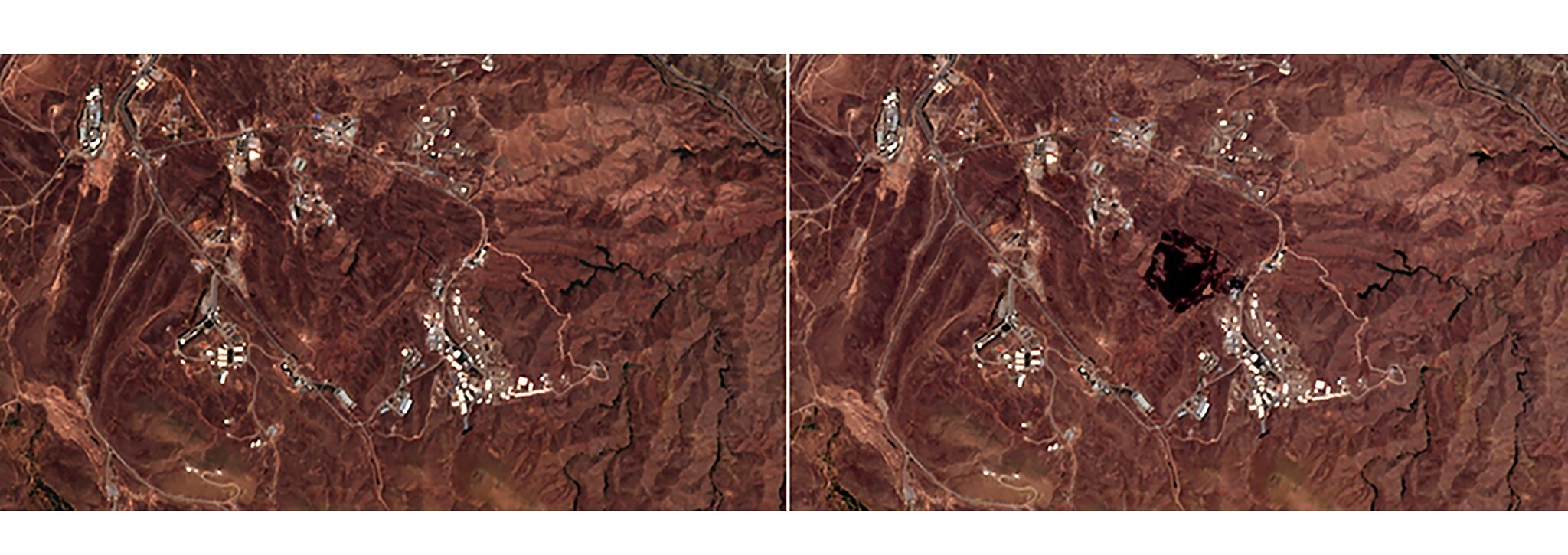
This Friday, June 26, 2020, photo combo from the European Commission’s Sentinel-2 satellite shows the site of an explosion, before, left, and after, right, that rattled Iran’s capital. Analysts say the blast came from an area in Tehran’s eastern mountains that hides an underground tunnel system and missile production sites. The explosion appears to have charred hundreds of meters of scrubland. (European Commission via AP)The Fars news agency, which is close to the country’s ultra-conservatives, initially reported that the blast was caused by “an industrial gas tank explosion” near a facility belonging to the defense ministry. It cited an “informed source” and said the site of the incident was not related to the military.
However, this was largely disregarded by defense analysts as satellite photographs of the Parchin military complex emerged showing large amounts of damage at the site.
Later, Iranian Defense Ministry spokesman Davood Abdi blamed the blast on a leaking gas that he did not identify and said no one was killed in the explosion.
Satellite photos of the area, some 20 kilometers (12.5 miles) east of downtown Tehran, showed hundreds of meters (yards) of charred scrubland not seen in images of the area taken in the weeks ahead of the incident. The building near the char marks resembled the facility seen in the state TV footage.
The gas storage area sits near what analysts describe as Iran’s Khojir missile facility. The explosion appears to have struck a facility for the Shahid Bakeri Industrial Group, which makes solid-propellant rockets, said Fabian Hinz.
The Washington-based Center for Strategic and International Studies identified Khojir as the “site of numerous tunnels, some suspected of use for arms assembly.” Large industrial buildings at the site visible from satellite photographs also suggest missile assembly being conducted there.
Iranian officials themselves also identified the site as being home to a military base where the International Atomic Energy Agency previously said it suspects Iran conducted tests of explosive triggers that could be used in nuclear weapons. Iran long has denied seeking nuclear weapons, though the IAEA previously said Iran had done work in “support of a possible military dimension to its nuclear program” that largely halted in late 2003.
Western concerns over the Iranian atomic program led to sanctions and eventually to Tehran’s 2015 nuclear deal with world powers. The US under President Donald Trump unilaterally withdrew from the accord in May 2018, leading to a series of escalating attacks between Iran and the US, and to Tehran abandoning the deal’s production limits.
The Associated Press contributed to this report.
[Disclaimer]







